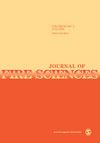四种哈龙替代品与哈龙1301的灭火性能比较
IF 1.9
4区 工程技术
Q2 ENGINEERING, MULTIDISCIPLINARY
引用次数: 5
摘要
用于船舶机舱的哈龙1301固定气体灭火系统已在世界范围内被禁止生产,因为哈龙破坏臭氧层。因此,有必要寻找一种环保、兼容、高效的替代消防系统。在本研究中,我们在ISO9705标准室内对四种替代灭火剂以及哈龙1301进行了灭火试验。根据各药剂的冷却效果、氧气浓度的稀释效果、油池火灾的灭火时间和柴堆的再燃概率来确定各药剂的灭火效率。试验结果从灭火效率方面为哈龙1301替代品的选择提供了数据支持。其中,Novec 1230对油池火灾的扑灭能力最好,HFC-227ea对柴堆火灾的扑灭能力最好。各灭火剂的冷却能力差异较小,其中惰性气体(IG-541)对氧气的稀释能力最好。热气溶胶灭火所需时间最长。因此,在现有设计标准下,HFC-227ea具有更好的灭火效率,更适合替代哈龙1301。本文章由计算机程序翻译,如有差异,请以英文原文为准。
Comparison of fire extinguishing performance of four halon substitutes and Halon 1301
The Halon 1301 fixed gas fire extinguishing system used in ship engine rooms has been banned from production all over the world, because halon destroys the ozone layer. Therefore, it is necessary to find an environmentally friendly, compatible and efficient alternative firefighting system. In this study, we performed fire extinguishing tests in an ISO9705 standard room for four alternative fire extinguishing agents, as well as Halon 1301. The fire extinguishing efficiency of each agent was determined based on its cooling effect, dilution effect of oxygen concentration, the extinguishing time of the oil pool fire and the re-ignition probability of the wood stack. The test results provide data support for the selection of alternatives of Halon 1301 from the aspect of fire extinguishing efficiency. Among these results, Novec 1230 had the best ability to put out the oil pool fire, and HFC-227ea suppressed the wood stack fire the best. The difference between the cooling ability of each fire extinguishing agent was small, and the inert gas (IG-541) displayed the best ability to dilute oxygen. Hot aerosol required the longest time to extinguish fire. Consequently, under the existing design standards, HFC-227ea had the better firefighting efficiency, more suitable to replace Halon 1301.
求助全文
通过发布文献求助,成功后即可免费获取论文全文。
去求助
来源期刊

Journal of Fire Sciences
工程技术-材料科学:综合
CiteScore
4.00
自引率
0.00%
发文量
14
审稿时长
2.5 months
期刊介绍:
The Journal of Fire Sciences is a leading journal for the reporting of significant fundamental and applied research that brings understanding of fire chemistry and fire physics to fire safety. Its content is aimed toward the prevention and mitigation of the adverse effects of fires involving combustible materials, as well as development of new tools to better address fire safety needs. The Journal of Fire Sciences covers experimental or theoretical studies of fire initiation and growth, flame retardant chemistry, fire physics relative to material behavior, fire containment, fire threat to people and the environment and fire safety engineering. This journal is a member of the Committee on Publication Ethics (COPE).
 求助内容:
求助内容: 应助结果提醒方式:
应助结果提醒方式:


